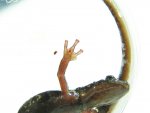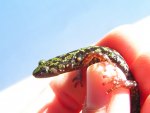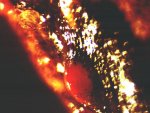As mentioned in my September, 2011 entry our plan was to take a mite-infested Green Salamander to Jim Petranka at Univ. of North Carolina at Asheville where he would excise out the mites and later key them to species. That was done but even under a scanning electron microscope Jim was unable to get sufficient details to do the keying, and he has since retired. But in October, 2014 we excised two mites from a Green while in the field. They were immediately preserved in ethanol and then provided to David Stephan, a recently retired entomologist at NCSU. His analysis showed them to definitely be a species of Hannemania and that it was highly likely they were H. dunni Sambon.
Larval Hannemania mites burrow through the skin of salamanders and anurans and encapsulate just under the skin. Externally, the encapsulated larvae appear as conspicuous orange to red colored spots approximately 1 mm in diameter. The mites can remain inside hosts for at least six months and it is unclear what causes them to emerge, but eventually they do and then burrow into the soil to become nonparasitic adult soil mites.
The literature indicates that Hannemania dunni have been found on several species of salamanders (Desmognathus fuscus, D. brimleyorum, Eurycea cirrigera, Plethodon cylindraceus, P. ouachitae, P. caddoensis and P. fourchensis, and on at least one species of frog (Rana palustris).
In our own field work we have not observed these mites, even in cases of heavy infestation, to cause mortality or even obvious discomfort to the Greens. However, other researchers have noted the following for hosts heavily parasitized by Hannemania species of mites. Male Plethodon angusticlavius are less aggressive in territorial disputes during fights with males that have low parasite loads (Maksimowich & Mathis 2000).Males with high parasite loads also have longer latency to foraging times compared to males with low parasite loads (Maksimowich & Mathis 2000).Infestation of the snout can cause damage to the nasolabial groove (Anthony et al. 1994) and this can reduce the chemosensory capability of salamanders and in turn reduce foraging ability and mate acquisition (Jaeger 1981; Dawley 1984).Nonparasitized females can detect parasite loads of males through use of pheromonal markers and nonparasitized females appear to prefer males that also have low parasite loads (Maksimowich & Mathis 2001).




